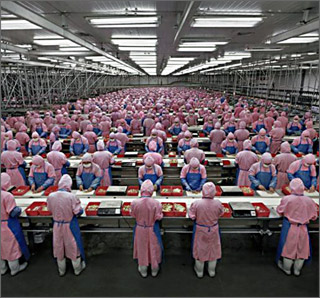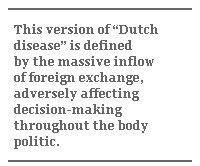Capitalism with Special Chinese Characteristics
Capitalism with Special Chinese Characteristics

Enlarge image
NEW HAVEN: On the surface, China’s economy glitters. Yet the double-digit growth that entices investors from around the globe is only one of many symptoms of a troubling economic phenomenon that wreaks havoc with political decision-making.
China has an overwhelming vigor, its teeming millions all scrambling for individual success with widespread anticipation of the upcoming Olympics and Expo. Clearly, China wants the tallest buildings, the biggest dam, the fastest train and the largest foreign-exchange reserves. Equally clear, China has less concern about mounting environmental degradation as well as income and gender imbalances.

While accelerating rates of income and employment growth in recent decades have lifted 300 million Chinese out of poverty, the condition still persists for 200 million in the rural interior. The gap between the two Chinas, urban and rural, is palpable, growing and receiving increased attention. Indeed, China’s overall income distribution as measured by the Gini coefficient (perfect equality is 0, perfect inequality is 1) is fast approaching .6, the highest anywhere in the world, and a far cry from the .2 level, one of the lowest, at the time Deng Xiaoping introduced his market-oriented reforms in 1978. Much of this growing inequality is geographically based, with the coastal provinces enjoying high rates of growth and the interior lagging substantially behind.
While the industrial construction “crane“ has become China’s “national bird,” life for 50 percent of the population – the farmers who don’t have medical coverage or assured pensions, who don’t own their land and are taxed in direct and indirect ways – remains harsh. In fact, farmers cultivate land on long-term leases, and governments could sell it out from under them. These local bodies can then use the proceeds, augmented by local bank credit, to continue investing at high rates, despite Beijing’s current efforts to cool the economy.
The basic cause of these anomalies in a country that continues to call itself communist – and is currently engaged in an effort to enhance “social harmony” in the context of 10-percent-plus growth rates – is a particular type of Dutch Disease. The economic ailment acquired its name from the1960s natural-gas boom in the Netherlands and is generally defined as the impact of a raw-material export spurt, possibly along with related foreign-capital inflows, on strengthening the exchange rate.
Such an appreciation of the currency implies a shift away from labor-intensive export sectors that are becoming less competitive internationally and toward domestic non-traded goods, also enhancing inflationary pressures.

China has thus far resisted letting its exchange rate appreciate much – despite international pressure – and instead continues to accumulate foreign-exchange reserves resulting from her mounting trade surpluses. As a consequence, China has managed to postpone most of the negative impact of the garden-variety “Dutch Disease.”
But another version of that disease could be more relevant in China’s case, one defined as the massive inflow of foreign exchange, from whatever source, adversely affecting decision-making throughout the body politic. The Chinese version of this phenomenon results from the continuing large-scale export surpluses caused by massive labor-intensive exports, associated with the maintenance of an undervalued exchange rate, and accompanied by large-scale foreign direct investment flows as well as some speculative portfolio capital. As labor surpluses in the coastal provinces are gradually exhausted, these “vent for surplus” activities move into the interior, continuing to fuel the overall investment boom.
China’s cumulative export surpluses since the late 1980s have amounted to $386 billion and inflows of FDI to $994 billion. With foreign-exchange reserves well above the $1 trillion mark, the Chinese government finds itself unable to cool down the boom – investments currently still run at 40 percent of GDP – all of which has led to lower levels of efficiency, i.e., falling rates of return and rising industrial capital-output ratios.
With saving rates nearing 50 percent and consumption continuing to lag as families worry about the need to finance their own health care and pensions down the road, we witness Beijing’s inability to rein in local governments’ continuing investment binges.
Households have two choices: put their money into government banks which continue to lend to local bodies – regardless of what the central government’s monetary and fiscal authorities have to say on the subject – or chase stocks or real estate in highly volatile asset markets.

In other words, this version of Dutch Disease is not caused by a natural-resource bonanza but massive labor-intensive exports plus large-scale capital imports, which affect not the exchange rate but the decision-making process. With enough resources around to buy off any and all stakeholders, incentives to push for reforms or pressure for care in lending and rational decision-making are reduced. Foreign investors remain anxious to maintain a competitive foothold in a market that continues to promise large future returns, and domestic financial institutions at the center are not sufficiently mature to impose their will on local bodies. No one feels obliged to blow the whistle as long as the bonanza lasts.
Such an unremitting avalanche of foreign exchange in the presence of a relatively fixed and undervalued exchange rate plus weak financial-sector institutions not only renders the central authorities incapable of restraining the continuing investment boom, but also encourages rent-seeking, corruption and rural unrest, all publicly lamented and hopefully beginning to be addressed.
Momentum for reform is difficult if most important actors see little reason to overcome a comfortable state of inertia. Quite the opposite, the continued accumulation of reserves provides incentives for influence peddling and inefficient investment activity.
Other nations have had to cope with the phenomenon. Prior to the discovery of large oil reserves in the 1990s, Nigeria once was a reasonably well governed society with balanced growth between agriculture and non-agricultural activities. Since then, Nigeria, once a grain exporter, has neglected agriculture so completely that it now must import most of its food needs. The Transparency International Index lists Nigeria as the most corrupt developing country.

Indonesia’s historical experience during the Suharto regime is equally relevant. There are two Indonesias, a heavily populated Java, capable of exporting labor-intensive industrial goods, and some of the outer oil-rich islands. Over time, whenever oil prices were relatively low, governance was generally sound, reforms were encouraged, including the maintenance of a realistic exchange rate favorable to Java’s light industry exports. On the other hand, whenever the oil price was relatively high, the head of Pertamina, the state-owned petroleum company, had Suharto’s ear; reforms were reversed, corruption boomed, with directed credit, white-elephant investments and other manifestations of crony capitalism rampant.
In other words, a massive reserve build-up makes it politically difficult to change policy. No urgent pressure emerges, and few want to offend politically powerful stakeholders.
Thus, strange as it may seem, the “natural resource curse” has a counterpart in a labor-surplus plus foreign-investment inflow condition – if a system is institutionally incapable of accommodating such a potentially beneficial bonanza.
What emerges is the phenomenon of “crony socialism” or, as I’m sure Beijing would prefer, “Dutch Disease with Special Chinese Characteristics.”
The way out seems clear: financial reforms, including a more competitive banking system, inducing the creation of a bond market, a more flexible exchange rate, giving farmers clear ownership of their land, generally redressing the unfavorable terms of trade for rural China, and a willingness to accept a cooled 6 to 7 percent growth rate, appropriate for a middle-income emerging country.
Gustav Ranis is the Frank Altschul Professor Emeritus of International Economics at Yale University.